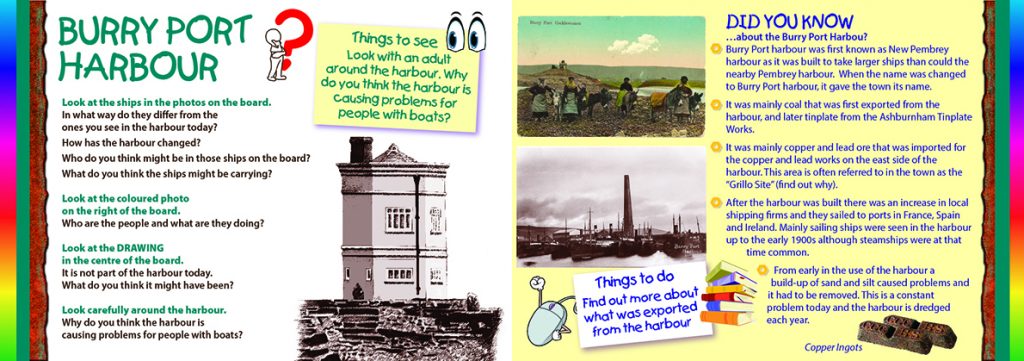Opened in 1832, the new harbour replaced the redundant Pembrey harbour.
BURRY PORT HARBOUR
Before Burry Port harbour was built in the 1830s the town did not exist, as up until the early 19th century, the population centre had been Pembrey. Despite Pembrey harbour having opened in 1819, growing industrial pressures meant it would not be large enough to serve the interests of the Gwendraeth Valley mine owners and other industrialists of the area. Therefore interested parties sought and secured an Act of Parliament in 1825 to form the Pembrey New Harbour Company. The venture had the backing of regional industrial investors whose names are still remembered today including the Pemberton Family, and was provided with expert advice in the form of professional engineers and eminent local seafarer Captain John Wedge.
The original plans were for a tidal harbour with loading facilities on the west side, of a similar design but slightly larger than Pembrey harbour. When the harbour was initially declared open in 1832 it was these elements that had been built with a scouring reservoir to the north. Not long after this opening disaster struck when the harbour walls collapsed, followed later by the scouring reservoir walls! The harbour remained partially open while repairs and redesigns were implemented. The opportunity to improve the loading facilities of the harbour was taken and new plans drawn up by noted canal engineer of the day James Green which included a substantial floating dock occupying the whole of the area of the scouring reservoir. A floating dock would allow larger vessels to use the harbour that otherwise would be stranded on receding tides. These plans never fully came to fruition but the benefits of a floating dock were too great and so the east dock was constructed by 1840.
This staggered opening is the reason why Burry Port’s first shipment by boat is taken to be in 1832 when the sailing brig of 300-tons called the Nimis docked in the port, despite the harbour not officially opening for another 4 years! The harbour was also connected to the transport network of the Kidwelly and Llanelly Canal and Tramroad Company, and so to the Gwendraeth Valley mines. It would also be connected to local mines and industries at Cwm Capel and New Lodge via tramroads. The harbour was built primarily from local quarried stone coming from a quarry at Cwm Capel, known locally as Cwar Mac after William McKiernon a noted engineer involved in the KLLCT and the new harbour repairs. The stone was carted initially by horse and cart from Cwm Capel, but was swiftly replaced by a tramroad, the route of which is known locally today as the Tramway.
The massive works undertaken to construct the harbour drew many people to the area for work. This growing population was focussed on the new harbour area. To save confusion between the two harbours an amendment to the Act of Parliament was passed in 1835 to change the name to Burry Port Harbour, and the town took on the name at the same time. The harbour and linked transport networks attracted a small number of industries to the harbour side, which brought even more workers to the slowly growing town also. These industries are explored elsewhere on this website. Although the population growth was a fraction of nearby Llanelli’s, it still brought significant changes to the character of the area
For a short period between 1888-1900 the scouring reservoir on the west side was converted to have coal loading facilities but later returned to a scouring reservoir, when demand was too low, and the shifting sands needed more regular flushing. Trade fluctuated slightly over the years with exports of anthracite and steam coal being the main goods, while from 1897 tinplate exports also features. Copper and lead ores and pit-wood dominated the import lists. This small but steady activity brought general prosperity to the area, while the relatively healthy atmosphere (the density of industry and population was not high enough to cause excessive pollution), meant the area remained attractive to people seeking work.
Local Shipping firms operated out of the harbour, naming their boats to reflect their Welsh roots – SS Pembrey, SS Pemscoe, Afon Gwyli, Afon Dyfi. These ships operated mainly between Burry Port and ports in France, Spain and Ireland. The port operated commercially until 1948 when trade failed to return after the Second World War ended. The harbour has changed hands on a number of occasions during its life with the first owners forming the Burry Port Harbour Company in 1835. Because the harbour company and the (newly formed) railway company shared many of the same investors they were merged, and so the Gwendraeth Valley Railway Company took ownership in 1866. This railway company eventually became the Burry Port & Gwendreath Valley Railway Company in 1868. The local railway remained the owners until they and their assets were incorporated into the Great Western Railway in 1922. When GWR was merged with the other railway companies to form British Railways in 1948, their maritime acquisitions were transferred to the British Transport Docks, although from that time it no longer operated as a commercial port.
From 1960 Burry Port Urban Council took over its running before the political map was changed and Llanelli Borough was formed in 1974. When the political structure was changed again in 1996, it passed to Carmarthenshire County Council who continue to operate it today. From 1948 until the present day the harbour has been dominated by fishing and leisure craft. A refit as part of the Millennium Coastal Park improvements saw the installation of a sill to allow the harbour to be used as a marina.

